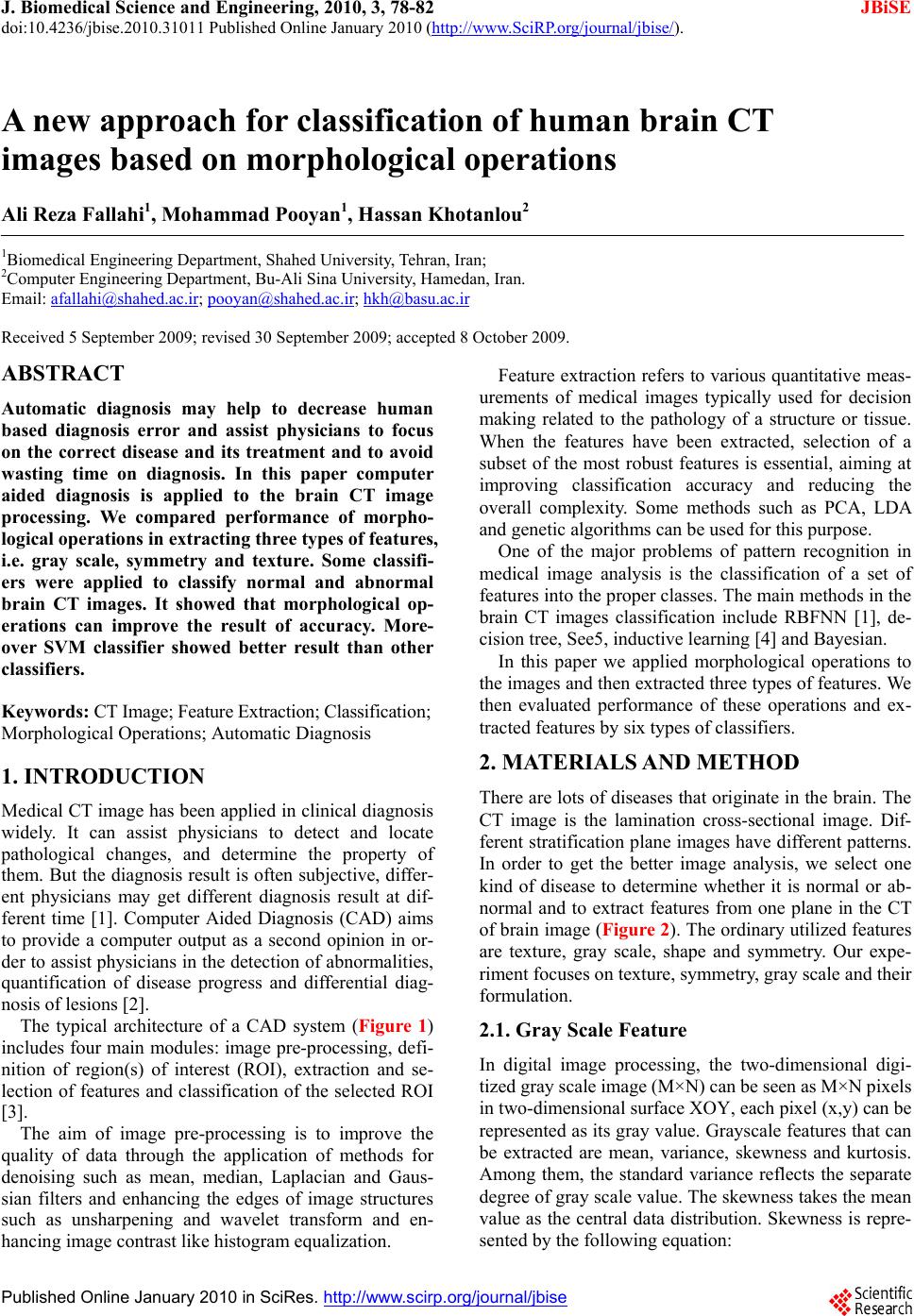
J. Biomedical Science and Engineering, 2010, 3, 78-82
doi:10.4236/jbise.2010.31011 Published Online January 2010 (http://www.SciRP.org/journal/jbise/
JBiSE
).
Published Online January 2010 in SciRes. http://www.scirp.org/journal/jbise
A new approach for classification of human brain CT
images based on morphological operations
Ali Reza Fallahi1, Mohammad Pooyan1, Hassan Khotanlou2
1Biomedical Engineering Department, Shahed University, Tehran, Iran;
2Computer Engineering Department, Bu-Ali Sina University, Hamedan, Iran.
Email: afallahi@shahed.ac.ir; pooyan@shahed.ac.ir; hkh@basu.ac.ir
Received 5 September 2009; revised 30 September 2009; accepted 8 October 2009.
ABSTRACT
Automatic diagnosis may help to decrease human
based diagnosis error and assist physicians to focus
on the correct disease and its treatment and to avoid
wasting time on diagnosis. In this paper computer
aided diagnosis is applied to the brain CT image
processing. We compared performance of morpho-
logical operations in extracting three types of features,
i.e. gray scale, symmetry and texture. Some classifi-
ers were applied to classify normal and abnormal
brain CT images. It showed that morphological op-
erations can improve the result of accuracy. More-
over SVM classifier showed better result than other
classifiers.
Keywords: CT Image; Feature Extraction; Classification;
Morphological Operations; Automatic Diagnosis
1. INTRODUCTION
Medical CT image has been applied in clinical diagnosis
widely. It can assist physicians to detect and locate
pathological changes, and determine the property of
them. But the diagnosis result is often subjective, differ-
ent physicians may get different diagnosis result at dif-
ferent time [1]. Computer Aided Diagnosis (CAD) aims
to provide a computer output as a second opinion in or-
der to assist physicians in the detection of abnormalities,
quantification of disease progress and differential diag-
nosis of lesions [2].
The typical architecture of a CAD system (Figure 1)
includes four main modules: image pre-processing, defi-
nition of region(s) of interest (ROI), extraction and se-
lection of features and classification of the selected ROI
[3].
The aim of image pre-processing is to improve the
quality of data through the application of methods for
denoising such as mean, median, Laplacian and Gaus-
sian filters and enhancing the edges of image structures
such as unsharpening and wavelet transform and en-
hancing image contrast like histogram equalization.
Feature extraction refers to various quantitative meas-
urements of medical images typically used for decision
making related to the pathology of a structure or tissue.
When the features have been extracted, selection of a
subset of the most robust features is essential, aiming at
improving classification accuracy and reducing the
overall complexity. Some methods such as PCA, LDA
and genetic algorithms can be used for this purpose.
One of the major problems of pattern recognition in
medical image analysis is the classification of a set of
features into the proper classes. The main methods in the
brain CT images classification include RBFNN [1], de-
cision tree, See5, inductive learning [4] and Bayesian.
In this paper we applied morphological operations to
the images and then extracted three types of features. We
then evaluated performance of these operations and ex-
tracted features by six types of classifiers.
2. MATERIALS AND METHOD
There are lots of diseases that originate in the brain. The
CT image is the lamination cross-sectional image. Dif-
ferent stratification plane images have different patterns.
In order to get the better image analysis, we select one
kind of disease to determine whether it is normal or ab-
normal and to extract features from one plane in the CT
of brain image (Figure 2). The ordinary utilized features
are texture, gray scale, shape and symmetry. Our expe-
riment focuses on texture, symmetry, gray scale and their
formulation.
2.1. Gray Scale Feature
In digital image processing, the two-dimensional digi-
tized gray scale image (M×N) can be seen as M×N pixels
in two-dimensional surface XOY, each pixel (x,y) can be
represented as its gray value. Grayscale features that can
be extracted are mean, variance, skewness and kurtosis.
Among them, the standard variance reflects the separate
degree of gray scale value. The skewness takes the mean
value as the central data distribution. Skewness is repre-
sented by the following equation: